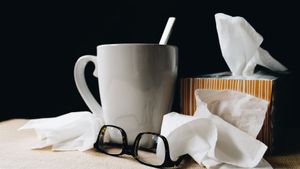YOGYAKARTA The mushrooms at home that grow on walls or on books, toys, clothes, and even compact disks (CD) not only damage goods but also cause health problems. During the rainy season, or high humidity, the house also absorbs moisture, causing in-house mushrooms to appear.
Indoor fungal growth is likely to occur during fall and winter, reported by Medical News Today, Tuesday, December 5. In Indonesia, mushrooms have the potential to appear when rainfall is high, air humidity increases, and exposure to the sun is not full every day. There are many types of mushrooms, but those that grow in the room produce sporamies that may spread from the environment.
There is no way to prevent sporas from spreading. So they can survive in no-growing conditions. Sporas will grow into mushrooms in humid and warm environments. They can grow on various surfaces, including fabrics, paper, wood, glass, and plastic. When growing, mushrooms or molds, may damage the ingredients where they grow.
Apart from no means of preventing the spora from spreading, no one knows very well how many types of mushrooms there are. But experts estimate there may be 300,000 or more types of mushrooms. Some of the types may appear at home compared to others. The mushrooms that grow in humid, wet areas such as under the sink or shower, including the Alternaria type. The mushrooms that often grow in the room, such as walls, are Asperangllus. For those that can grow in cool or warm areas, including on the wooden surface, are Cladosporium. Penicillium tends to grow on damaged surfaces due to water and often greenish blue.
Sporas that make moldy houses can be carried by air. It can also stick to objects or people and pets. Areas that are often moldy, there are usually water leaks, floods, windows where condensation is formed, and places where the air does not circulate.
Mushrooms can cause health problems, especially for people who have allergies. Including having respiratory problems and a weak immune system. Sporas and dictionarys, can produce allergens, irritation, and micotoximation. Some of them can be toxic, especially for people who have high sensitivity to allergens and are easily irritated.
Fungal particles can irritate the lungs, nose, and throat. Especially in people who already have respiratory problems, asthma, or chronic lung conditions. The fungal allergy, can cause symptoms such as fever and affect the upper respiratory tract. Other symptoms, in the form of stuffy or runny nose, itchy nose, itchy throat, sneezing, and runny eyes.
In people who have a low immune system, they can experience severe reactions. It is called acarillosis, which affects the lungs and causes respiratory problems. AscarILLosis, among others, sinusitis asjalanllus is allergic, aspergelloma, and chronic pulmonary asgolalosis.
Mushrooms can also trigger microbial and bacterial production. Exposure to bacteria can trigger an inflammatory response to some people, according to WHO. Some other evidence, exposure to sporaous mushrooms may lead to pneumonia hypersensitivity, bronchitis, alleolitis allergies, chronic rhinosinusitis, sinusitis of allergic fungi, and respiratory tract problems in children.
SEE ALSO:
Other evidence also suggests that someone who spends a lot of time in an environment where there are mushrooms, experiences skin and eye irritation, mengis, fever, fatigue, nausea, headache, insomnia, irritation of mucus membranes, and sick-building syndrome.
As protection and prevention of health decline because the environment is moist or in a moldy house, it is important to control the humidity of the house. For example, by keeping air circulation working well.
The English, Chinese, Japanese, Arabic, and French versions are automatically generated by the AI. So there may still be inaccuracies in translating, please always see Indonesian as our main language. (system supported by DigitalSiber.id)


















